Butternut Squash Cappellacci di Zucca
Butternut Squash Cappellacci di Zucca is a wonderful, traditional Italian pasta dish with a fall flair. Roasted butternut squash is wrapped in homemade pasta and served with crispy sage and brown butter sauce along with my addition, a bit of marinara sauce
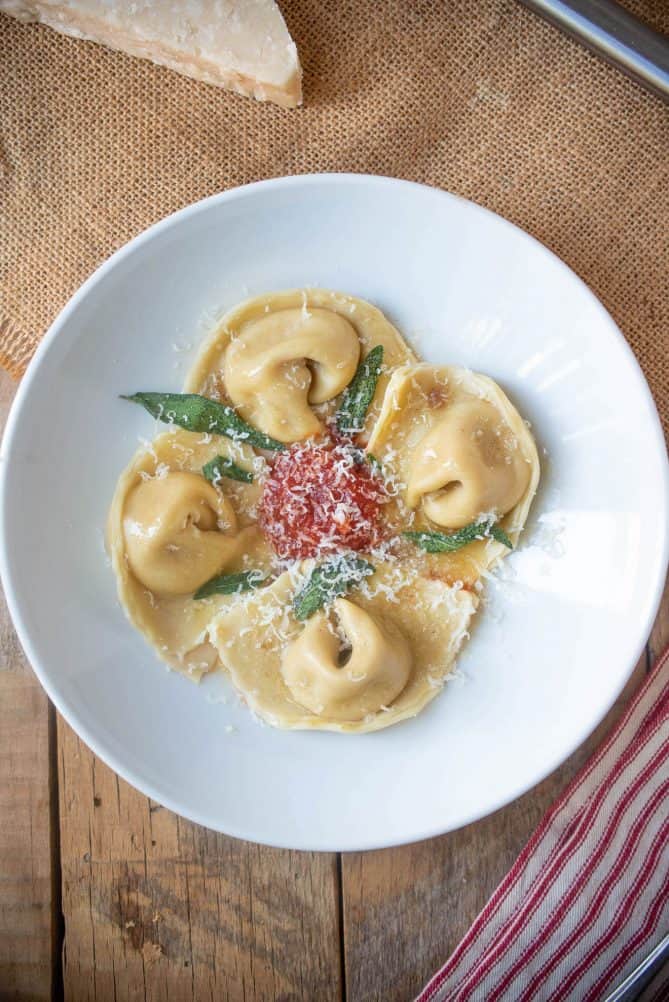
This butternut squash pasta dish is chock full of all the amazing flavors of fall/autumn all rolled into tiny little packages! For me, this is the trifecta of taste sensation, sweet butternut squash, nutty brown butter and earthy crispy sage. Once you make it, your taste buds will thank me!
This is one of my all time fall/autumn Italian pasta dishes that originates from Ferrara in the Northern Italy region of Emilia-Romagna (way up at the top of “the boot”, just south of Milan).
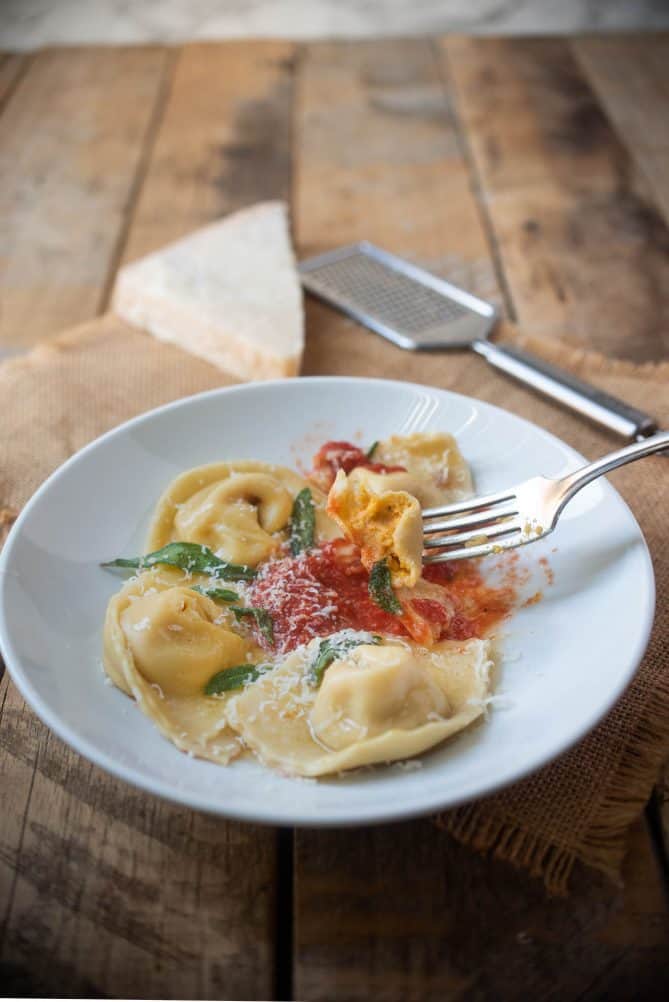
Making homemade pasta
I like to make my own pasta for this dish, but if you can find sheets of ready made pasta dough, by all means use that.
But… If you’ve never made your own pasta dough and have always wanted to try, consider this the time to give it a shot! I have a step by step video showing how easy it can be – and it is much easier than you might think. Pasta made at home with loving care is so much better than store bought and actually cooks up very quickly. You’ll feel like a super hero in your kitchen!
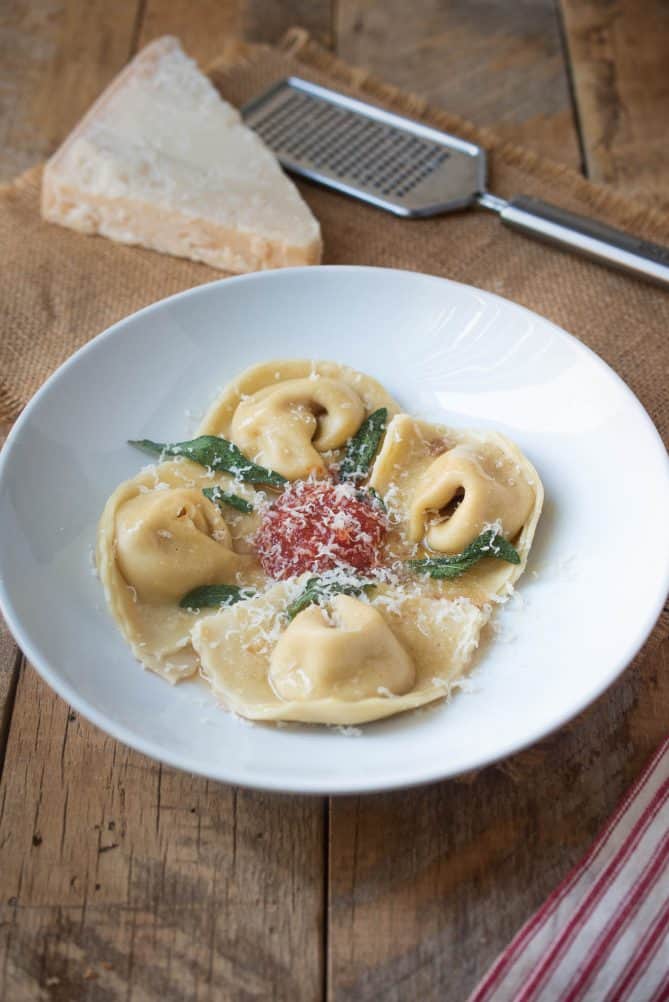
What does Cappellacci mean?
Cappellacci (roughly translated to bad/ugly hats in Italian) are folded in the traditional way to resemble an Italian nun’s headwear.
These little hats are made in a similar fashion to ravioli and tortellini and are filled with zucca violina (butternut squash). ‘Zucca’ being the general Italian term for any squash, including pumpkin.
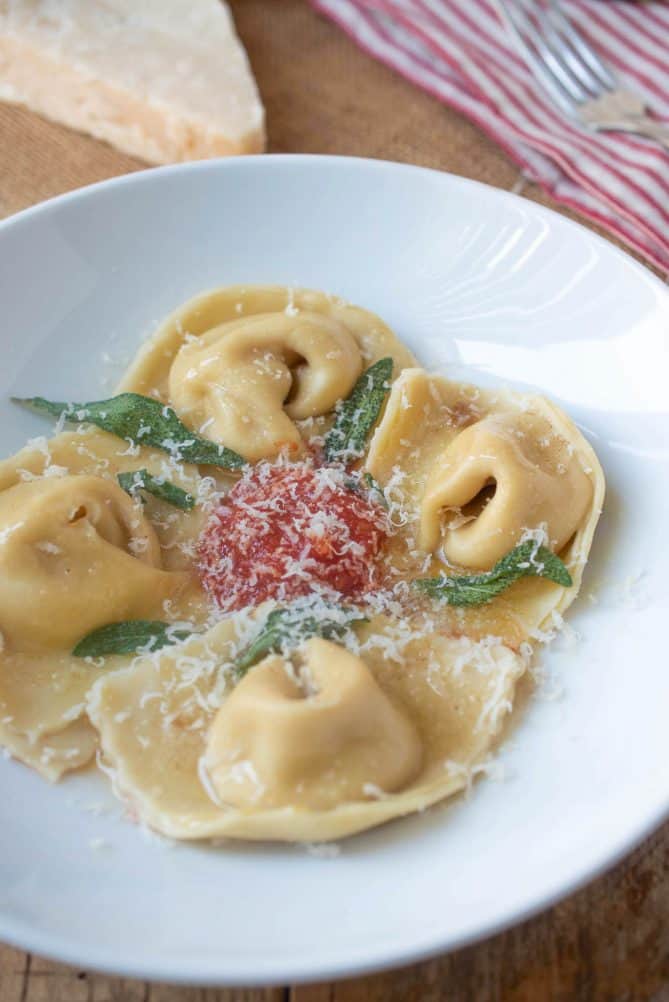
My favorite way to serve Butternut Squash Cappellacci di Zucca is the exact same way I serve my Pumpkin Ravioli, with crispy sage, butter and just a touch of homemade marinara sauce (< click for link). The sauce helps cut through the richness of the filling and butter.
In Italy, all stuffed pastas have different names and they are all distinguished by the shape that they are ultimately folded into. Cappellacci pasta is similar to tortellini (or tortelloni) except tortellini start with a round piece of dough and cappellacci start with square pieces of dough.
Cutting a butternut squash
Because squash is very hard when raw, cutting up any squash can be difficult and dangerous so be careful and make sure you have a sharp knife and keep track of each cut carefully.
As an easier alternative, you can cut the squash in half, scoop out the seeds and roast each half on a baking sheet rubbed with oil, dried sage, salt and pepper (flesh-side up) at 400°F/200°C for 50-60 minutes until fork tender.
Preparing the butternut squash filling
To prepare the filling, I prefer to cut the butternut squash into cubes first, then roast them up until they’re tender with salt, pepper and dried sage.
If you’ve made this Butternut Squash Cappellacci di Zucca, please give a star rating in the recipe. Or, if you have a question or comment, you can leave that below.
Butternut Squash Cappellacci di Zucca
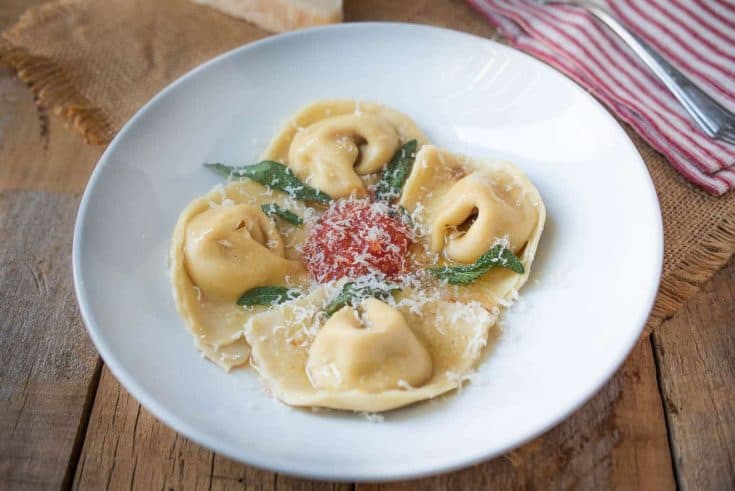
Butternut squash filled homemade pasta served with brown butter, crispy sage and marinara sauce.
Ingredients
- For roasting the butternut squash:
- 1 large butternut squash, peeled and cut into cubes to yield 1 1/4 cups (327 grams)
- 3 tablespoons olive oil
- 2 teaspoons dried sage
- 1 teaspoon salt
- Small pinch ground black pepper
- For the pasta:
- 3 cups ( 255 grams) all purpose flour
- 4 large eggs, room temperature
- 1/2 teaspoon salt
- 2 tablespoons olive oil
- Water
- To prepare the filling:
- 1/2 cup ( 68 grams) ricotta cheese
- 1/2 cup (22 grams) Parmesan cheese
- 1 large egg, beaten
- To finish the dish:
- 1 cup (227 grams) butter
- A handful fresh sage leaves
- Marinara sauce (optional)
Instructions
- Preheat oven to 400°F/200°C.
- For roasting the butternut squash: Spread the butternut squash onto a large baking sheet. Drizzle with oil, sage, salt and pepper. Mix well and spread into an even layer. Roast for 25 minutes or until they are tender when a fork is inserted. Remove and allow to cool.
- For the pasta: On a clean work surface or in a large mixing bowl, make a mound with the flour and create a well in the middle and add the eggs, salt and olive oil.
- Using a fork, beat the eggs and oil and begin to incorporate the flour from the inner rim of the mound, making sure the mound stays intact with the other hand. The dough will start to come together. Start to drizzle in 1/3 cup (78 ml) water. You may not use it all, you just need the dough moist enough to come together in a ball. You can use your hands at this point. The dough should stay together, not be dry and not be to sticky to handle. If it’s too dry, add a tiny bit more water, if too wet, a little flour. Knead using the palm of your hand to push away from you, stretching the dough for about 3 minutes on a lightly floured surface until smooth. Rub your hands together to remove any dough that sticks. The dough is ready when it does not stick to your hands or the surface and should be a nice smooth dough.
- Once the dough is soft and smooth form it into a ball, wrap it in plastic wrap, making sure it is well wrapped so no areas of the dough dry out. Allow to rest at room temperature. You can also keep it well wrapped refrigerated for up 1 week or freeze for 3 months.
- For preparing the filling: Add the cooled butternut squash to a food processor and puree until smooth. You can also mash it well by hand. Add the mashed squash, ricotta, Parmesan and egg to a bowl. Mix well. Set aside.
- Make the pasta dough: Dust your work surface with flour. Cut a 1/4 piece of the dough, keep the unused portion of the dough well covered until ready to use. Flatten the piece of dough with your hands into a small rectangle. With your pasta machine on the widest setting (usually 1), pass the dough through 2 or 3 more times increasing the setting by 1 each time, guiding with your hands as it comes out, keeping it flat. If the dough gets sticky, dust with flour. The best thickness is usually setting 2 or 3. Using a pasta/ravioli cutting wheel, cut the dough into 4-inch (10 cm) squares.
- Filling the pasta: Place a small amount of butternut squash mix into the center of each square. Use your finger to lightly wet 1 edge, then fold in half, pressing the edges well to seal. Holding it with the folded side down, take the left and right corners and carefully bring them together. Seal. Place them on a board or sheet pan while to complete the rest. You can see this done in the attached video.
- If you want to freeze them, put them in a freezer on something flat (not touching) for 2 hours, then add them to a freezer bag or container. This way they won’t stick together.
- To a frying pan, add the butter over medium heat. Once melted and bubbly, add the sage leaves and cook until crispy. Remove and drain onto a towel, reserve the butter.
- Bring a large pan of water to a boil.
- Once the water is boiling, carefully add the pasta, don’t crowd the pan or they will stick together. As soon as they float, scoop out using a slotted spoon and put into the pan of butter to coat. Transfer them to a serving plate and top with the crispy sage and Parmesan cheese. Serve with a side of tomato pasta sauce.
Nutrition Information
Yield
6Serving Size
1Amount Per Serving Calories 425Total Fat 18gSaturated Fat 4gTrans Fat 0gUnsaturated Fat 13gCholesterol 160mgSodium 624mgCarbohydrates 53gFiber 3gSugar 1gProtein 13g
This nutrition calculation is provided by Nutronix that is only a guideline and not intended for any particular diet.
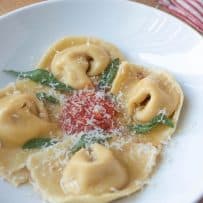
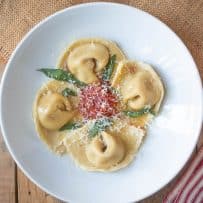
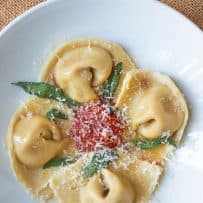

6 Comments on “Butternut Squash Cappellacci di Zucca”
Delicious! I was afraid to make my own pasta, but now that I’ve made this and it was a hit, I will do it next time. The flavors are so good together and I love your tip about adding marinara. My picky teenager had 2 servings so I know I got it right 🙂
I’m so happy it was a hit. I hope you do make your own pasta next time, let me know how it goes.
In the video when making the butternut squash filling you use an egg. In the written recipe you include olive oil but no egg in the ingredients for the filling. I presume there is an egg in the filling but no olive oil, correct?
The egg is listed further down the recipe with the ricotta. I write the ingredients in the order they are used that is why the olive oil is up with the butternut squash for roasting in the first steps, but the egg is not used until the filling is blended. I’ve added headlines to make this easier to read. Let me know if you have any other questions.
Ah, I get it! Thanks for the quick response! I have never tried making any kind of pasta before but I would like to give this one a go since it looks really good (and I have sage growing in my garden!). Mary
You’re welcome, fresh sage is the best. Let me know if I be of any more help.